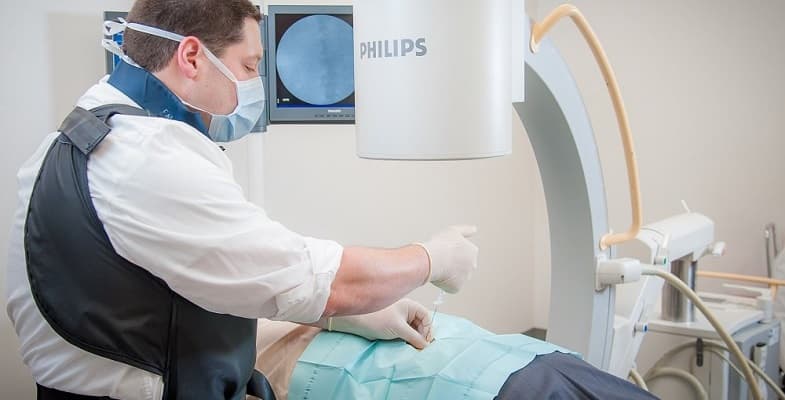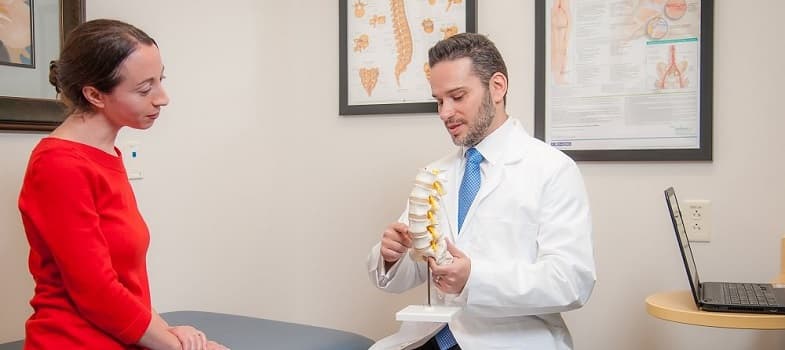What is a Lumbar Sympathetic Block?
A lumbar sympathetic block involves injecting medications into a nerve bundle in the lower back. It is used to diagnose and treat pain disorders of the lower extremities that are sustained by the sympathetic nervous system (SNS).
The SNS is implicated in numerous pain syndromes that cause neuropathic and other types of pain. In order to treat the pain and determine the role of the SNS in the transmission of pain, the doctor may prescribe an anesthetic blockade of the sympathetic ganglia. If the nerve block alleviates the patient’s pain, the doctor may employ more permanent forms of pain relief such as chemical or thermal neurolysis1.
The function of the sympathetic nervous system (SNS) is to sustain the body physiologically in emergency or high-stress situations such as combat, pursuit, and pain. In order to best appropriate the body’s resources in stressful conditions, the SNS initiates certain adaptive physical reactions. For example, it constricts blood vessels supplying the skin and shunts blood toward more vital organs; dilates blood vessels supplying the heart, skeletal muscles and lungs to promote peak physical ability; and releases glucose from the liver for quick energy. These physiological changes are intended to promote optimal performance in demanding situations.
Within the SNS are ganglia (singular: ganglion), or bundles of nerves. In fact, the SNS is comprised anatomically of approximately 21 sympathetic ganglia that form chains on either side of the thoracic and lumbar regions of the spinal column. The lumbar area of the spine typically contains four sympathetic ganglia that innervate the lower body. Lumbar sympathetic nerve blocks target any of these four ganglia. For pain conditions involving the upper body, blockade of the stellate ganglion in the upper body is commonly prescribed. Lumbar sympathetic and stellate ganglion blocks are the same with the exception of the injection site and the region of the body targeted.
The activities of the SNS oppose those of the parasympathetic nervous system (PNS), which regulates events that typically occur when the body is in a restful state. Examples of PNS activities include digesting food, lowering heart rate, constricting pupils, and dilating blood vessels. The PNS is also involved in sexual arousal. The oppositional functions of the SNS and the PNS are why they are nicknamed the “fight or flight” system and the “feed and breed” system, respectively.
The SNS and PNS function involuntarily; in other words, they operate independently of conscious thought and individuals have limited or no control over their activities. This automaticity is the reason that these systems are collectively called the autonomic nervous system. A comprehensive term used to describe any disease or malfunction of the autonomic nervous system is dysautonomia. Treating dysautonomia can be difficult and typically necessitates a combination of therapies.
Conditions Related to Lumbar Sympathetic Block
Injury or irritation of sympathetic nerves can adversely affect circulation in the hands, feet, or other areas, and can produce pain and sensory changes. This can result in a condition known as Complex Regional Pain Syndrome (CRPS), also called Reflex Sympathetic Dystrophy (RSD). The main symptom of CRPS is intense, continuous, burning pain that usually occurs in the extremities. Often, the pain may begin at the site of a traumatic injury but spread throughout an entire limb. Eventually, the pain may migrate to the opposite side of the body.
Another pain condition that may respond to sympathetic blockade is Sympathetically Maintained Pain (SMP), or pain that is maintained or facilitated by some form of sympathetic nervous system activity2. SMP is similar to CRPS; however, patients with SMP may not exhibit all the signs and symptoms of full-blown CRPS3. SMP may be a feature of several types of painful conditions and is not an essential requirement of any one condition4.
The pain of CRPS, SMP, and other SNS-facilitated conditions can be provoked by stimuli that are not usually painful, such as the touch of a feather on the skin (allodynia). In addition, patients with these conditions may find that a normally painful stimulus may cause disproportionately severe irritation and pain (hyperalgesia). Allodynia and hyperalgesia are signs of central sensitization. In this condition, local tissue injury and inflammation activate the PNS, which sends signals to the central nervous system (CNS). The excitability of neurons within the CNS increases, causing normal inputs from the PNS to produce abnormal responses. Low-threshold sensory fibers activated by light touch excite neurons in the spinal cord that would normally respond to more painful stimuli. As a result, a light touch that would normally produce a harmless sensation now produces significant pain. Since it is easier to prevent central sensitization with early treatment, patients are encouraged to seek medical help for chronic pain as soon as possible. If sympathetic pain goes untreated, it may become irreversible.

A lumbar sympathetic block involves injection of a local numbing anesthetic (e.g., lidocaine, bupivacaine) and a corticosteroid into the region containing the target sympathetic nerve ganglion. Sometimes other agents are included in the medications delivered, such as ketamine, which has an adjuvant effect, and guanethidine, which reduces the release of SNS hormones (catecholamines).
Generally, the patient will be given intravenous (IV) sedation to promote comfort during the procedure. The physician uses painless fluoroscopy to help visualize the area being injected. Fluoroscopy is an x-ray imaging technique that provides real-time, live images of the internal structures of a patient through the use of an X-ray source and fluorescent screen. Following the procedure, which takes an estimated 15 minutes, the physician monitors the patient to evaluate the effects of the nerve block upon the patient’s pain.
If a patient experiences pain relief from a sympathetic nerve block, the pain is likely related to the SNS and it is expected that a series of additional sympathetic nerve blocks will be beneficial. The relief may increase in intensity and duration with each subsequent block. Even if a sympathetic nerve block does not provide a patient with pain relief, the procedure has diagnostic value as it allows the physician to rule out SNS involvement as a cause of the patient’s pain.
Individuals who experience pain relief during a nerve block may be invited to participate in physical therapy while blockade is in effect and wide dynamic range neurons are being rested5. The goal of such therapy is to rehabilitate joints and strengthen the muscles in affected areas.
Watch this Patient Review
Benefits of Lumbar Sympathetic Block
The most significant benefit of a lumbar sympathetic block is the rapid relief of symptoms afforded to many patients with chronic SNS-related pain. Most patients who respond to lumbar sympathetic blocks regain the ability to resume their normal daily activities. In addition, sympathetic nerve blockade is a minimally invasive treatment. Less invasive therapies carry lower rates of complications than more aggressive, riskier treatments such as surgical sympathectomy. Surgery carries a higher risk of infection and other serious complications than less invasive therapies.
The efficacy of a lumbar sympathetic block is backed by a number of clinical trials. For example, a Japanese study concluded neural blockade could contribute to the improvement of pain intensity and lowered opioid consumption without unpredictable, serious side effects6. Further, a randomized double-blind placebo-controlled crossover study in patients who received either lumbar sympathetic lidocaine or placebo (saline) found lumbar sympathetic blockade also produced significant reduction in pain intensity compared to pretreatment values of allodynia to brush, pinprick and pinprick temporal summation and verbal pain scores in the active treatment group7. And a study in patients with abdominal or pelvic cancer pain found lumbar sympathetic blocks provided significant reduction of pain and opioid consumption, and boosted quality of life8.
As with any medical procedure, the lumbar sympathetic block is associated with risks. However, the minimally invasive nature of this treatment makes it a safe and reasonable non-surgical approach to pain relief.
Reported complications of the lumbar sympathetic block include infection, bleeding, pneumothorax (collapsed lung), nerve damage, and pharmacological complications related to the drugs utilized9. In addition, some patients experience soreness at the injection site. Occasionally, blockade of sympathetic nerves can cause transient side effects such as drooping of the eyelid and nasal congestion; however, these effects typically resolve within hours.
The prognosis for SNS-driven pain syndromes is generally improved with early diagnosis and treatment. Sometimes, if the condition is caught during early stages, restored range of motion and even remission are possible. Without early diagnosis and treatment, changes to tissues will eventually become irreversible. Patients who live with CRPS and other painful conditions are encouraged to seek help as soon as possible to prevent long-term damage that cannot be reversed.
Wake Spine & Pain Specialists understands the burden of living with pain and strives to help patients regain their quality of life. Our caring practitioners are dedicated to working closely with patients to create individualized pain management programs designed to restore good health and happiness. To investigate treatment options for your CRPS, call to schedule an appointment with us today.
References
- Day M. (2008). Sympathetic blocks: the evidence. Pain Pract., 8(2), 98-109.
- Caneris, O. (1998). The new alphabet soup of pain management. NeuroNews Newsletter, 1(2), Retrieved from www.neneuro.com/nn_2_pain_management
- Carden, E. (2011). Complex regional pain syndrome (CRPS). Informally published manuscript, School of Medicine, University of California, Santa Monica, CA. Retrieved from[PDF]www.forgrace.org/documents/carden-nonphysician.pdf
- Carden, E. (2011). Complex regional pain syndrome (CRPS). Informally published manuscript, School of Medicine, University of California, Santa Monica, CA. Retrieved from[PDF]www.forgrace.org/documents/carden-nonphysician.pdf
- Carden, E. (2011). Complex regional pain syndrome (CRPS). Informally published manuscript, School of Medicine, University of California, Santa Monica, CA. Retrieved from[PDF]www.forgrace.org/documents/carden-nonphysician.pdf
- Tei Y, Morita T, Nakaho T, Takigawa C, Higuchi A, Suga A, Tajima T, Ikenaga M, Higuchi H, Shimoyama N, & Fujimoto M. (2008). Treatment efficacy of neural blockade in specialized palliative care services in Japan: a multicenter audit survey. J Pain Symptom Manage., 36(5), 461-7.
- Meier PM, Zurakowski D, Berde CB, & Sethna NF. (2009). Lumbar sympathetic blockade in children with complex regional pain syndromes: a double blind placebo-controlled crossover trial. Anesthesiology., 111(2), 372-80.
- de Oliveira R, dos Reis MP, & Prado WA.(2004). The effects of early or late neurolytic sympathetic plexus block on the management of abdominal or pelvic cancer pain. Pain., 110(1-2), 400-8.
- Elias M. (2000). Cervical sympathetic and stellate ganglion blocks. Pain Physician., 3(3), 294-304.


